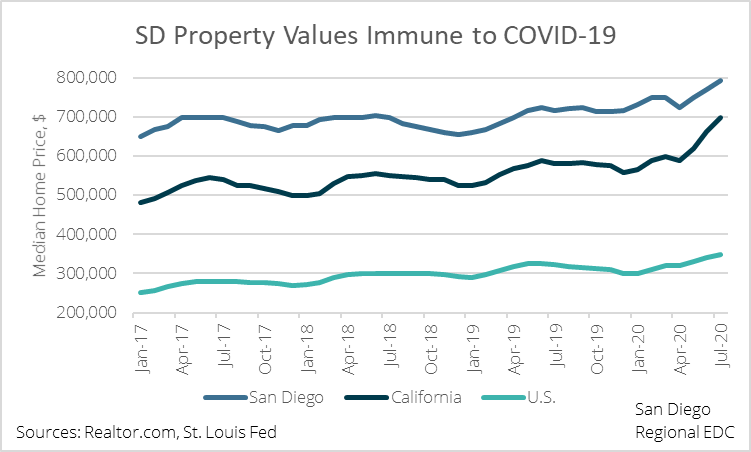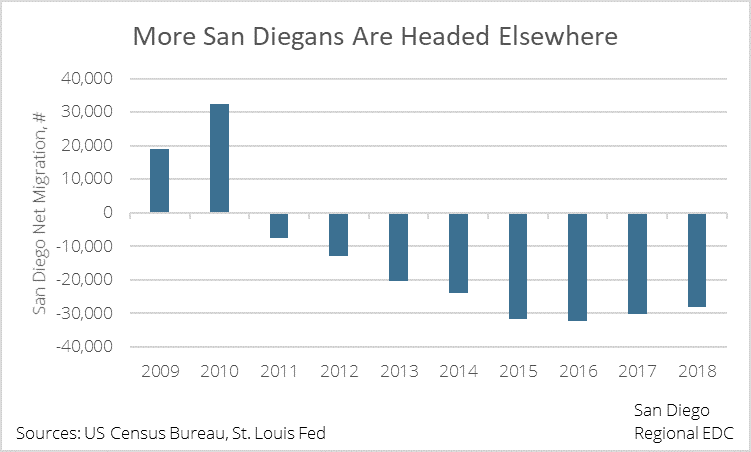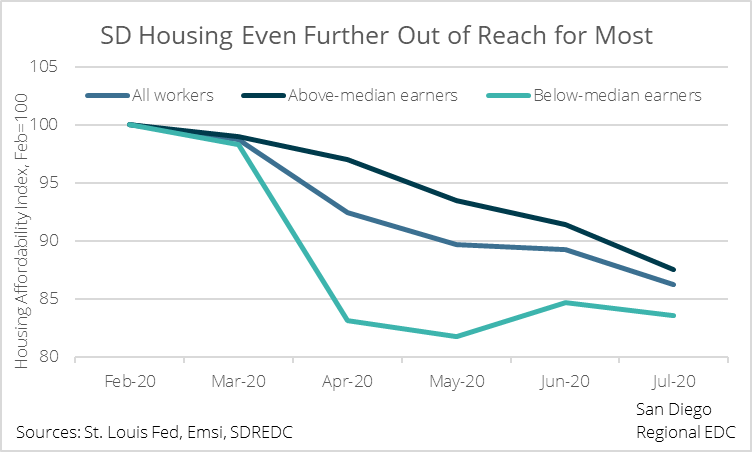THE TAKEAWAYS…
- House prices continued to climb locally, despite record job losses from COVID
- Lower mortgage rates, strong population growth, the addition of high-earning newcomers to the region, and a razor-thin inventory of available houses have fueled house price growth
- The evidence suggests that thousands of people are being priced out of San Diego each year, which could cause talent bottlenecks for local employers and drive labor costs higher
- Building new housing will be crucial to making San Diego a more affordable place for people to live in the future
HOUSING STILL ON A TEAR
COVID-19 has done little, if anything, to cool down San Diego’s hot housing market. Depending on the source, the median home price in the region was up in July of this year anywhere from roughly 5% to more than 10% from a year prior. Meanwhile, rents are essentially flat to just slightly down over the past year even as personal income cratered an estimated 10.5% from February to April. Earnings have crawled back as job gains resumed in the summer months but still remain well below pre-COVID levels.

WHY HOUSING HASN’T FALTERED
So, how can the local housing market possibly support climbing prices and some of the highest rents in the country amid record unemployment? A combination of factors are at play, many of which are specific to San Diego.
First, falling mortgage rates lured more homebuyers into the market in the summer following an initial decline in April and May as the COVID outbreak worsened. Existing-home sales rebounded sharply in June and were up more than 10% from a year prior by July. Additional buyer interest drove prices higher.
Second, the pandemic disproportionately hurt workers in lower-paying fields while many workers in higher-paying industries shifted to remote work, allowing landlords and home sellers to charge prices at or near (or higher) than before the outbreak, especially for upper-tier properties.
Finally, San Diego boasts a national and international allure for high earners for its climate, lifestyle, and concentration of tech-related innovation jobs. More people have moved out of San Diego than moved here in recent years, but those moving in to the region tend to make about four times as much than those moving out, allowing home sellers and renters to keep prices elevated.

Therein lies the problem. Reframing the point above, it appears that residents are being forced out because they simply can’t afford to live here anymore, while the people moving in have secured employment in high-paying fields.
It’s important to note that net migration only measures people moving across county lines and doesn’t include organic population growth as people start families, people live to be older, etc. Overall, San Diego’s total population grew by more than 235,000 residents, or 7.6%, between 2010 and 2019—well above the 6.1% growth experienced nationwide. Housing supply has failed to keep up, and the result has been a steady climb in already-high housing prices locally.
THE REPERCUSSIONS
Housing affordability—measured as the ratio between earnings and median house prices—fell for all workers between February and July. This is in spite of the fact that higher-paid workers were, in most cases, able to continue working through the pandemic. However, housing affordability in San Diego is still farther from reach for lower-paid workers, underscoring the affordability issue faced for employees in fields outside of San Diego’s innovation economy, which includes tech and life sciences. Earnings for workers making less than the median salary of $73,596 per year dropped an estimated 19.5%, compared with a relatively less severe 7.3% decline for workers making above the median.

This creates an issue, since it limits the number of workers available in the region for fields outside of white-collar professions and may potentially create a talent bottleneck that could ultimately force labor costs higher. This is especially important for businesses operating within the tourism sector, including restaurants, bars, hotels, casinos, and retail shops already operating on tight margins that could have more difficulty absorbing rising labor costs than firms in other industries with greater pricing power.
Above-average population growth, above-average earnings for many employees, and a constricted housing inventory have created a perfect storm of unaffordable housing in San Diego. Expanding the supply of housing, as well as cultivating additional mass transit options—another topic in and of itself—will therefore be crucial to helping balance the market and ensuring San Diego retains its diverse talent pool.
Regardless of how this all plays out, EDC is here to help. You can use the button below to request our assistance with finding information, applying to relief programs, and more.
You also might like: